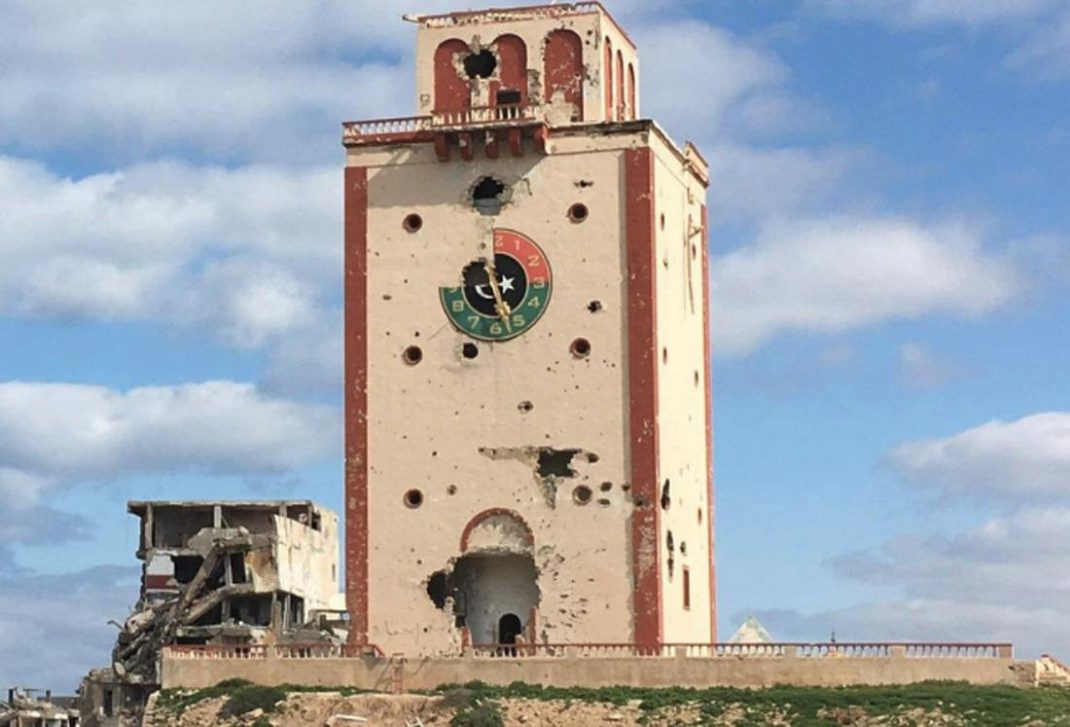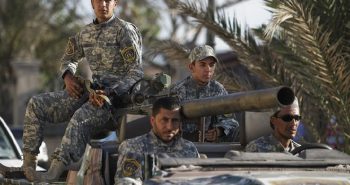By Jalel Harchaoui & Mohamed-Essaïd Lazib

 The Libyan state lacked transparent, self sustainable institutions long before the 2011 uprisings. Hundreds of local disputes and tribal feuds lingered across the country for decades.
The Libyan state lacked transparent, self sustainable institutions long before the 2011 uprisings. Hundreds of local disputes and tribal feuds lingered across the country for decades.
PART THREE
The Revolutionary Groups
The Tripoli Revolutionary Battalion
The Tripoli Revolutionary Battalion (TRB) was established in the summer of 2011. It largely consisted of Tripolitanians who fled to the city of Nalut to join the preparation for the assault on the capital. Among its founders was the Libyan-Irish Islamist Mahdi al-Harati.
The TRB received material support from Qatar. The TRB’s original founders also enjoyed a rapport with Turkey’s Islamists.
By the end of 2011, however, the TRB splintered into several local groups that acted as independent police units known as Supreme Security Committees.
Two individuals then emerged at the helm of the TRB:
– Haythem al-Tajuri, a former police officer with a history of petty criminality, and
– Hashim Bishr, a moderate Salafi with sway among local militias and who had previously headed a local Supreme Security Committee.
Starting in early 2014, the TRB turned into an opponent of the Muslim Brotherhood and its allies. Although the TRB was nominally part of the Fajr Libya coalition, it did not contribute significantly to its military effort.
The TRB did, however, help protect the UN-backed GNA when it was established in March 2016. In return the TRB derived more privileges and more recognition as a cornerstone of the capital’s security apparatus.
Because the TRB’s top leaders have displayed a hostility to political Islam, the UAE and France have sought to dialogue with them. But these outside powers have found it difficult to control the TRB for two main reasons.
First, the brigade’s vivid anti-autocracy sentiment has persisted among several of its mid-level commanders. As a result, part of the TRB has remained fiercely opposed to Haftar in ways neither Tajuri nor Bishr can fully control.
Second, the TRB has unique access to Libya’s wealth through the banking system. Tajuri and some of his lieutenants are suspected of having embezzled tens of millions of dollars from Libya’s public treasury using fraudulent letters of credit and other schemes.
The sheer amount of money available inside Libya makes Tajuri and the TRB less immediately responsive to enticements offered by outside powers.
Amid the UAE’s long-standing efforts to undermine the TRB’s commitment to resisting the LNA, the Gulf federation adopted a somewhat more coercive approach in 2018. In late August, Tajuri and fellow TRB leader Bishr traveled from Saudi Arabia to the UAE, coincidentally when a major battle was erupting in Tripoli.
The UAE prevented Tajuri and Bishr from leaving. The former was compelled to remain in the country for three months. Before Tajuri’s return to Tripoli, a series of assassinations targeting several mid-level TRB leaders began in Tripoli.
It is suspected, but yet unproven, that the UAE pressed for these killings through a subset of Radaa or other Madkhali Salafi cells in Tripolitania. The targets were all TRB commanders particularly hostile to Haftar.
During that period, the TRB’s chiefs negotiated indirectly with the LNA about allowing Haftar entry into central Tripoli. Yet, ultimately, the UAE’s efforts to turn the TRB into an LNA-friendly force failed. The TRB-LNA tentative entente crumbled with Haftar’s April 2019 decision to attack Tripoli.
In order to avoid alienating other local actors and ensure his immediate survival amid an unforeseen assault, Tajuri publicly condemned the LNA’s offensive and the battalion emerged as a major obstacle in the first days of Haftar’s offensive. Soon afterward, however, the TRB disengaged from parts of the front line and Tajuri himself left Libya.
Tajuri’s ambivalence amid the LNA’s onslaught shows how fluid allegiances can be in Libya: no external entity controls actors on the ground.
Misrata’s Mahjub Brigade
The Mahjub Brigade is a revolutionary formation that takes its name from a district in Misrata’s western suburbs. Founded during the 2011 siege of the city, Mahjub participated in the battles of Misrata, Tripoli, and Sirte that same year.
Despite its inclusion in the Misrata Military Council, the Mahjub Battalion (later a brigade) kept its structural independence.
In 2011 it benefited from military equipment shipped by Qatar via Benghazi. The militia is nowadays considered the city’s second largest force in terms of personnel and materiel.
Although it is largely made up of civilian fighters committed to the revolutionary cause, it is organized like a regular military brigade. The Mahjub Brigade is led through informal consensus by a group of mostly civilian leaders.
It has enforced some internal rules and maintained a relatively coherent public stance. Its leadership has sanctioned or expelled members when they were involved in blatantly criminal activities.
Since 2015 the Mahjub Brigade has developed a close relationship with the Misratan merchant class. It often adopts a pragmatic stance on socioeconomic issues, which distinguishes it from the hard-line factions of Misrata.
The force exhibits frequent personnel turnover as members become recruited into different security and military organizations. The Mahjub militia’s size exceeds 2,500 active fighters and possesses the ability to mobilize many more from former members.
It played a central role in Misrata’s July 2014 attack on Zintani forces in southern Tripoli. The Mahjub Brigade also spearheaded the Misratan-led assault on Ibrahim Jadhran’s Petroleum Facilities Guard (PFG) in the Oil Crescent region in December 2014.
Yet Mahjub Brigade’s leadership showed themselves to be open to calls for a ceasefire, which helped to de-escalate the conflict in the Oil Crescent. The Mahjub Brigade also supported the national dialogue process that led to the establishment of the GNA in 2016.
Along with other moderate militias from Misrata, including the Halbous and Hattin Brigades, it prevented hardline militias from impeding the GNA’s arrival in Tripoli in March 2016.
In military terms, the Mahjub Brigade is a significant component of that bloc, which is neither Islamist nor revolutionary in its inclination. When, in early 2016, ISIS expanded its presence beyond Sirte and attempted to seize the Oil Crescent’s terminals, the Mahjub Brigade supported Jadhran materially and coordinated a military action with the latter against a common enemy.
Separately, from May through December 2016, the Mahjub Brigade participated in a US-backed campaign to uproot ISIS from Sirte.
After ISIS was dislodged, the Misratan armed group took part in security initiatives such as the Central Military Region’s Sirte Protection Force and the Misrata-Sirte Coastal Road Protection Room, as well as the Ministry of Defense’s Counter-Terrorism Force, based in Khoms but largely staffed by Misratans.
Mahjub’s attitude toward the GNA soured after the battle of Sirte, however. Brigade leaders criticized the GNA’s lack of support, its inefficiency, and its bias toward Tripoli-based militias.
They complained that Tripoli-based militias had deepened and expanded their territorial control in the capital while the Misratans were engaged in the campaign against ISIS in Sirte.
In 2017 Mahjub commanders were among a delegation that met with Qatari emir Tamim bin Hamad al-Thani in Doha. Most of these figures had been involved in the battle for Sirte and hailed from Misrata, including members of the municipal council and the central hospital’s director.
The GNA’s defense minister and other Libyan state officials objected to the move, claiming that it was tantamount to Misrata conducting its own foreign policy. Moreover, the move came just a week after Saudi Arabia and the UAE announced their blockade of Qatar.
The latter’s contribution to 2016’s anti-ISIS campaign in Sirte was in fact far less significant than the aid provided by Britain, Italy, and the US. Nevertheless, the examples above demonstrate Mahjub’s tendency to conduct its own diplomacy.
Ibrahim Jadhran’s Petroleum Facilities Guard
Ibrahim Jadhran is a native of Ajdabiya and a former inmate of the notorious Abu Salim prison. Jadhran is not a radical Islamist but a mere criminal with no strong commitment to a particular ideology. He took advantage of the 2011 uprisings to present himself as a revolutionary.
In 2012 Saddiq al-Gheithi, a former Islamist fighter in Afghanistan and, at the time, a deputy defense minister in charge of border security, put Jadhran in charge of protecting the oil installations in Cyrenaica.
Public funds enabled Jadhran to recruit militiamen from his tribe, the Magharba, in Ajdabiya, and stand up a large armed group called the Petroleum Facilities Guard (PFG).
In 2013 Ibrahim Jadhran’s PFG blockaded Cyrenaica’s major oil terminals located within the Magharba tribal domain. Jadhran claimed this blockade was to protest the lack of salaries from the government. He also claimed that the Tripoli government had illegally siphoned off the natural resource wealth of Cyrenaica. The blockade severely hurt Libya’s oil exports.
From 2014 to 2015 Haftar maintained a tactical alliance with Jadhran. Although there are rumors that the UAE and Saudi Arabia supported Jadhran from 2013 to 2015, it was unclear if Jadhran acted as a proxy for any foreign power.
In March 2014 US Navy SEALs stopped eastern Libya from conducting independent exports of oil. Later during Jadhran’s long-term blockade, Russians approached him and asked to be the oil’s exclusive buyers in exchange for arms and cash, to no avail.
Since 2016 Jadhran has found periodic refuge in Turkey. In May through August of 2016 US officials met the PFG chief several times in an attempt to negotiate a resumption of official oil exports by Tripoli.
In September 2016 the Magharba tribe expelled Jadhran and let Haftar take over the oil terminals. The LNA has since been responsible for the security and smooth operation of the oil terminals.
In June 2018 Jadhran launched a new assault on the Oil Crescent terminals. The Haftar camp claimed that Qatar had funded the attack, although evidence is again shaky. Haftar’s forces—with military or logistical assistance from the UAE, Egypt, and France—repelled Jadhran’s group and retook the terminals.
Jadhran fled to Misrata and then Istanbul. Later that year, the US and UN placed Jadhran on the sanctions list.
The Benghazi Defense Brigades
In 2016 Ismail al-Sallabi, a veteran of the Islamist brigades in Benghazi with strong ties to Qatar, cofounded the Benghazi Defense Brigades (BDB) with other militants from Benghazi and Ajdabiya.
A Benghazian commander by the name of Mustafa al-Sharkassi became the BDB’s chief. The militia attracted fighters who had previously been expelled from Benghazi and Ajdabiya and forced to relocate in western Libya as a result of Haftar’s Karama campaign.
Some were veterans of the Benghazi Revolutionaries Shura Council. Other BDB recruits were mere civilians with ancestry in Tripolitania who had been chased from their homes in Benghazi. The resentment of these non-Islamist families toward Haftar partly explains the emergence of BDB in May 2016.
The anti-Haftar militia initially had its headquarters in the south of Misrata and, later, in the Jufrah district. Forces of the port city, however, rejected the BDB after it carried out a surprise attack and massacre of pro-Haftar fighters at the Brak al-Shati air base in May 2017.
Under pressure from Misrata’s moderates, BDB officially dissolved, although some of its members remain active. Several BDB members participated in Jadhran’s attack on the Ras Lanuf and Brega oil terminals in June 2018.
After April 4, 2019, Sharkassi and a few other BDB figures returned from exile to join in the defense of Tripoli, anticipating a friendlier environment would result from Haftar’s offensive on Tripoli.
…
to continue
***
Jalel Harchaoui is a research fellow at the Clingendael Institute in The Hague. His work focuses on Libya’s politics and security. Most of this essay was prepared prior to his joining Clingendael.
Mohamed-Essaïd Lazib is a PhD candidate in geopolitics at University of Paris 8. His research concentrates on Libya’s armed groups and their sociology.
____________
BROOKINGS DOHA CENTER




